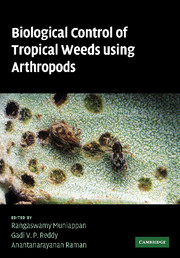Book contents
- Frontmatter
- Contents
- List of contributors
- Acknowledgments
- 1 Biological control of weeds in the tropics and sustainability
- 2 Acacia nilotica ssp. indica (L.) Willd. ex Del. (Mimosaceae)
- 3 Australian Acacia species (Mimosaceae) in South Africa
- 4 Ageratina adenophora (Sprengel) King and Robinson (Asteraceae)
- 5 Azolla filiculoides Lamarck (Azollaceae)
- 6 Cabomba caroliniana Gray (Cabombaceae)
- 7 Invasive cactus species (Cactaceae)
- 8 Chromolaena odorata (L.) King and Robinson (Asteraceae)
- 9 Clidemia hirta (L.) D. Don (Melastomataceae)
- 10 Coccinia grandis (L.) Voigt (Cucurbitaceae)
- 11 Eichhornia crassipes (Mart.) Solms–Laub. (Pontederiaceae)
- 12 Lantana camara Linn. (Verbenaceae)
- 13 Mimosa diplotricha C. Wright ex Sauvalle (Mimosaceae)
- 14 Mimosa pigra L. (Leguminosae)
- 15 Parthenium hysterophorus L. (Asteraceae)
- 16 Passiflora mollissima (HBK) Bailey (Passifloraceae)
- 17 Pistia stratiotes L. (Araceae)
- 18 Prosopis species (Leguminosae)
- 19 Salvinia molesta D. S. Mitchell (Salviniaceae)
- 20 Solanum mauritianum Scopoli (Solanaceae)
- 21 Application of natural antagonists including arthropods to resist weedy Striga (Oranbanchaceae) in tropical agroecosystems
- 22 Biological control of weeds in India
- 23 The role of International Institute of Tropical Agriculture in biological control of weeds
- 24 The role of Secretariat of the Pacific Community in the biological control of weeds in the Pacific Islands region – past, present, and future activities
- Index
24 - The role of Secretariat of the Pacific Community in the biological control of weeds in the Pacific Islands region – past, present, and future activities
Published online by Cambridge University Press: 04 August 2010
- Frontmatter
- Contents
- List of contributors
- Acknowledgments
- 1 Biological control of weeds in the tropics and sustainability
- 2 Acacia nilotica ssp. indica (L.) Willd. ex Del. (Mimosaceae)
- 3 Australian Acacia species (Mimosaceae) in South Africa
- 4 Ageratina adenophora (Sprengel) King and Robinson (Asteraceae)
- 5 Azolla filiculoides Lamarck (Azollaceae)
- 6 Cabomba caroliniana Gray (Cabombaceae)
- 7 Invasive cactus species (Cactaceae)
- 8 Chromolaena odorata (L.) King and Robinson (Asteraceae)
- 9 Clidemia hirta (L.) D. Don (Melastomataceae)
- 10 Coccinia grandis (L.) Voigt (Cucurbitaceae)
- 11 Eichhornia crassipes (Mart.) Solms–Laub. (Pontederiaceae)
- 12 Lantana camara Linn. (Verbenaceae)
- 13 Mimosa diplotricha C. Wright ex Sauvalle (Mimosaceae)
- 14 Mimosa pigra L. (Leguminosae)
- 15 Parthenium hysterophorus L. (Asteraceae)
- 16 Passiflora mollissima (HBK) Bailey (Passifloraceae)
- 17 Pistia stratiotes L. (Araceae)
- 18 Prosopis species (Leguminosae)
- 19 Salvinia molesta D. S. Mitchell (Salviniaceae)
- 20 Solanum mauritianum Scopoli (Solanaceae)
- 21 Application of natural antagonists including arthropods to resist weedy Striga (Oranbanchaceae) in tropical agroecosystems
- 22 Biological control of weeds in India
- 23 The role of International Institute of Tropical Agriculture in biological control of weeds
- 24 The role of Secretariat of the Pacific Community in the biological control of weeds in the Pacific Islands region – past, present, and future activities
- Index
Summary
Introduction
The Pacific Community comprises small islands spread over 30 million square kilometers of ocean, with land making up a fraction of this area. The region (Fig. 24.1), which stretches from Palau and Papua New Guinea (PNG) in the west, the Commonwealth of the Northern Mariana Islands in the northwest, to New Caledonia in the south and French Polynesia and the Pitcairn Island in the east, offers a suitable environment for the proliferation of many tropical, alien invasive weeds. Increasing volumes of trade and movement of people to and from the Pacific render the threat of new plant invaders an ever-increasing problem. Many weeds have been introduced into the region in the last 100 years following European contact. As a result, the region is already inundated by several invasive weeds that cause significant environmental, economic, and social problems for the local people (Meyer, 2001; Orapa, 2001; Dovey et al., 2004). Many of these weeds are difficult to control. On the other hand, the geographic nature of islands also offers unique opportunities for successful management of some weeds using relatively cheap and sustainable pest management methods such as biological control. Weed biological control capacity in the Pacific region is not as well developed as in developed countries, which have a long history of biological control.
- Type
- Chapter
- Information
- Biological Control of Tropical Weeds Using Arthropods , pp. 465 - 480Publisher: Cambridge University PressPrint publication year: 2009

